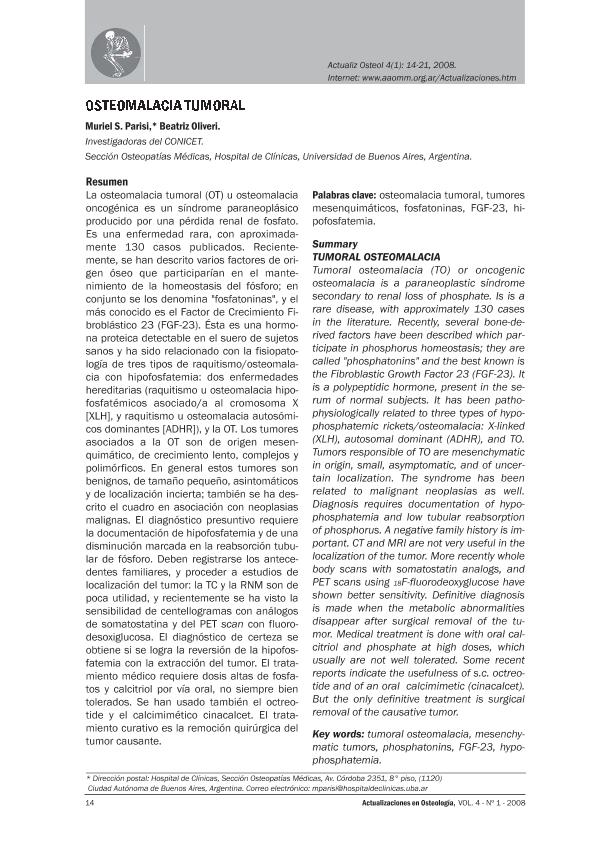Artículo
La osteomalacia tumoral (OT) es un síndrome paraneoplásico en el cual el paciente presenta dolor óseo, fracturas y debilidad muscular. Es producido principalmente por una elevación de los niveles en sangre del factor de crecimiento fibroblástico 23 (FGF-23). En la OT, el FGF-23 es secretado por tumores mesenquimales, los cuales se caracterizan por ser de tamaño pequeño y de lento crecimiento. El FGF-23 actúa a nivel de los túbulos renales afectando la reabsorción de fósforo, lo cual conduce a hipofosfatemia y a bajos niveles de 1,25-dihidroxivitamina D [1,25(OH)2D3]. El tratamiento de la OT es la resección del tumor. Debido a las características de estos tumores muchas veces no pueden ser localizados o son quirúrgicamente irresecables y requieren tratamiento médico a largo plazo, consistente en sales de fósforo y calcitriol. La adherencia al tratamiento muchas veces resulta difícil debido a las reacciones secundarias, así como también a las complicaciones asociadas. Tumoral osteomalacia (TO) or oncogenic osteomalacia is a paraneoplastic síndrome secondary to renal loss of phosphate. Is is a rare disease, with approximately 130 cases in the literature. Recently, several bone-derived factors have been described which participate in phosphorus homeostasis; they are called ?phosphatonins? and the best known is the Fibroblastic Growth Factor 23 (FGF-23). It is a polypeptidic hormone, present in the serum of normal subjects. It has been pathophysiologically related to three types of hypophosphatemic rickets/osteomalacia: X-linked (XLH), autosomal dominant (ADHR), and TO. Tumors responsible of TO are mesenchymatic in origin, small, asymptomatic, and of uncertain localization. The syndrome has been related to malignant neoplasias as well. Diagnosis requires documentation of hypophosphatemia and low tubular reabsorption of phosphorus. A negative family history is important. CT and MRI are not very useful in the localization of the tumor. More recently whole body scans with somatostatin analogs, and PET scans using 18F-fluorodeoxyglucose have shown better sensitivity. Definitive diagnosis is made when the metabolic abnormalities disappear after surgical removal of the tumor. Medical treatment is done with oral calcitriol and phosphate at high doses, which usually are not well tolerated. Some recent reports indicate the usefulness of s.c. octreotide and of an oral calcimimetic (cinacalcet). But the only definitive treatment is surgical removal of the causative tumor.
Osteomalacia Tumoral
Fecha de publicación:
12/2008
Editorial:
Asociación Argentina de Osteología y Metabolismo Mineral
Revista:
Actualizaciones en Osteología
ISSN:
1669-8975
e-ISSN:
1669-8983
Idioma:
Español
Tipo de recurso:
Artículo publicado
Clasificación temática:
Resumen
Archivos asociados
Licencia
Identificadores
Colecciones
Articulos(INIGEM)
Articulos de INSTITUTO DE INMUNOLOGIA, GENETICA Y METABOLISMO
Articulos de INSTITUTO DE INMUNOLOGIA, GENETICA Y METABOLISMO
Citación
Parisi, Muriel Solange; Oliveri, María Beatriz; Osteomalacia Tumoral; Asociación Argentina de Osteología y Metabolismo Mineral; Actualizaciones en Osteología; 4; 1; 12-2008; 14-21
Compartir




